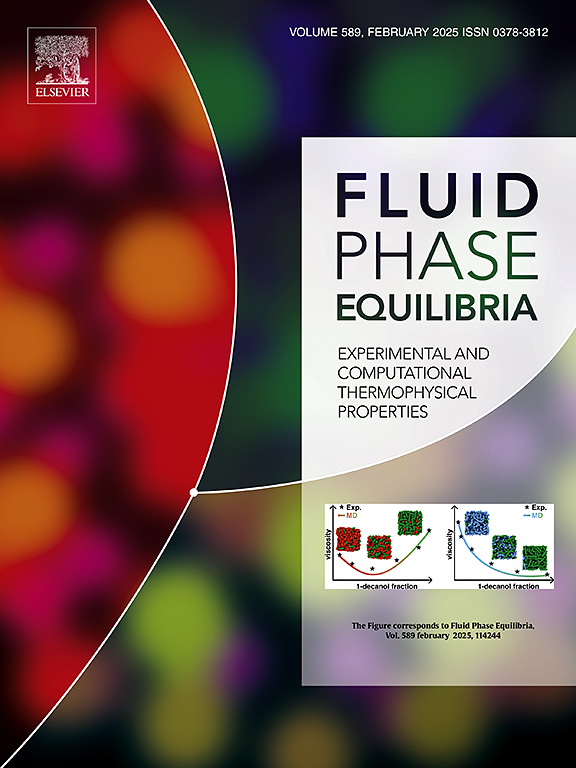Understanding the solubility behavior of 2,2′-bifuran-5,5′-dicarboxylic acid in different pure solvents
IF 2.8
3区 工程技术
Q3 CHEMISTRY, PHYSICAL
引用次数: 0
Abstract
The molecule 2,2′-bifuran-5,5′-dicarboxylic acid (BFDCA) has attracted significant attention due to its potential as a building block to form biorenewable polymers. However, there is no information available on the solubility of BFDCA in pure solvents, hindering the effective design for reaction, separation, and crystallization processes. The present work evaluated the solubility of BFDCA in eight different solvents at temperatures from 298.15 K to 363.15 K. On a mole fraction basis, the BFDCA solubility from high to low at 298.15 K followed the order: DMAc > DMSO > MeOH > 1-pentanol > 2-propanol > acetic acid > acetonitrile > H2O. Additional solubility tests were performed in cyclohexane, acetone, and dichloromethane, but the equilibrium solute concentration was below the detection limit of the instrument in the range of temperatures studied. The sigma (σ) profile of BFDCA shows that this molecule is strongly polar and can behave as a donor and acceptor of hydrogen bonds. A higher screening charge density was found in the hydrogen bonding (HB) donor regions in BFDCA, which would favor the interaction with the solvents’ HB acceptor regions. Correlations between BFDCA solubility and solvent property parameters show that solvents’ HB acceptor propensity and total basicity play an important role in the solute solubility, which agrees with the findings from the σ profile of BFDCA and solvents and linear energy solvation relationships (LSER). However, the dipole moment, dielectric constant, cohesive energy density, and surface tension also influence the BFDCA solubility since the evaluated molecular descriptors are insufficient to explain the solubility behavior in some cases. The Apelblat equation and the NRTL activity coefficient model aptly described the experimentally observed solubility with model fitting, whereas the COnductor-like Screening MOdel for Real Solvents (COSMO-RS) method predicted qualitative trends.

了解2,2 ' -双脲-5,5 ' -二羧酸在不同纯溶剂中的溶解度
分子2,2 ' -双脲-5,5 ' -二羧酸(BFDCA)由于其作为形成生物可再生聚合物的基石的潜力而引起了极大的关注。然而,没有关于BFDCA在纯溶剂中的溶解度的信息,这阻碍了反应、分离和结晶过程的有效设计。研究了BFDCA在298.15 ~ 363.15 K温度下在8种不同溶剂中的溶解度。以摩尔分数为基础,298.15 K时BFDCA溶解度由高到低依次为:DMAc >;DMSO祝辞甲醇比;1-pentanol祝辞丙胺比;醋酸>;乙腈比;H2O。在环己烷、丙酮和二氯甲烷中进行了额外的溶解度测试,但在研究温度范围内,平衡溶质浓度低于仪器的检测极限。BFDCA的sigma (σ)谱表明该分子具有强极性,可以作为氢键的供体和受体。在氢键(HB)供体区发现了较高的筛选电荷密度,这有利于与溶剂的HB受体区相互作用。溶质溶解度与溶剂性质参数的相关性表明,溶剂的HB受体倾向和总碱度对溶质溶解度有重要影响,这与BFDCA与溶剂的σ分布和线性能量溶剂化关系(LSER)的结果一致。然而,偶极矩、介电常数、内聚能密度和表面张力也会影响BFDCA的溶解度,因为所评估的分子描述符在某些情况下不足以解释其溶解度行为。Apelblat方程和NRTL活度系数模型通过模型拟合很好地描述了实验观察到的溶解度,而真实溶剂类导体筛选模型(cosmos - rs)方法预测了定性趋势。
本文章由计算机程序翻译,如有差异,请以英文原文为准。
求助全文
约1分钟内获得全文
求助全文
来源期刊

Fluid Phase Equilibria
工程技术-工程:化工
CiteScore
5.30
自引率
15.40%
发文量
223
审稿时长
53 days
期刊介绍:
Fluid Phase Equilibria publishes high-quality papers dealing with experimental, theoretical, and applied research related to equilibrium and transport properties of fluids, solids, and interfaces. Subjects of interest include physical/phase and chemical equilibria; equilibrium and nonequilibrium thermophysical properties; fundamental thermodynamic relations; and stability. The systems central to the journal include pure substances and mixtures of organic and inorganic materials, including polymers, biochemicals, and surfactants with sufficient characterization of composition and purity for the results to be reproduced. Alloys are of interest only when thermodynamic studies are included, purely material studies will not be considered. In all cases, authors are expected to provide physical or chemical interpretations of the results.
Experimental research can include measurements under all conditions of temperature, pressure, and composition, including critical and supercritical. Measurements are to be associated with systems and conditions of fundamental or applied interest, and may not be only a collection of routine data, such as physical property or solubility measurements at limited pressures and temperatures close to ambient, or surfactant studies focussed strictly on micellisation or micelle structure. Papers reporting common data must be accompanied by new physical insights and/or contemporary or new theory or techniques.
 求助内容:
求助内容: 应助结果提醒方式:
应助结果提醒方式:


